Kutz M. Handbook of materials selection
Подождите немного. Документ загружается.

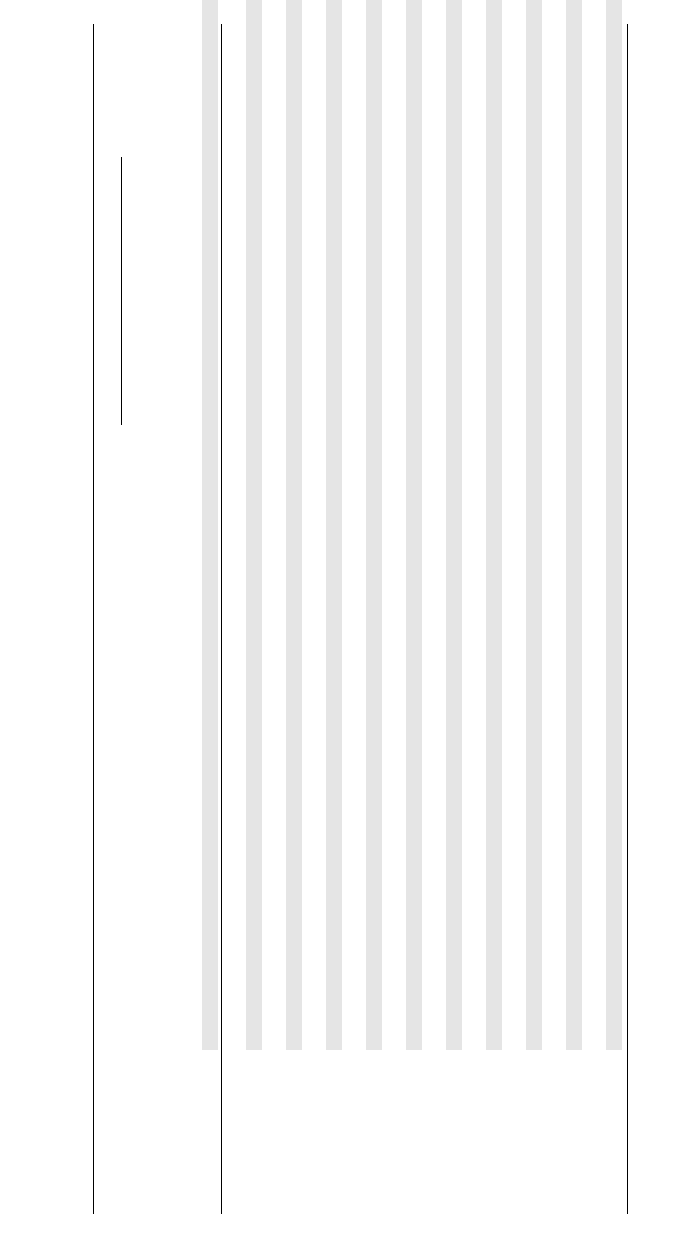
903
Table 16 Material Removal Rates and Dimensional Tolerances
Process
Maximum Rate
of Material
Removal
in.
3
/min
cm
3
/min
Typical
Power
Consumption
hp/ in.
3
/min
kW/cm
3
/min
Cutting
Speed
fpm
m/ min
Penetration
Rate per
Minute
in.
mm
Accuracy Ⳳ
Attainable
in.
mm
At Maximum
Material Removal
Rate
in.
mm
Typical
Machine
Input
hp
kW
Conventional
turning
200
3300
1
0.046
250
76
—
—
0.0002
0.005
0.005
0.13
30
22
Conventional
grinding
50
820
10
0.46
10
3
—
—
0.0001
0.0025
0.002
0.05
25
20
CHM 30
490
—
—
—
—
0.001
0.025
0.0005
0.013
0.003
0.075
—
—
PBM 10
164
20
0.91
50
15
10
254
0.02
0.5
0.1
2.54
200
150
ECG 2
33
2
0.019
0.25
0.08
—
—
0.0002
0.005
0.0025
0.063
4
3
ECM 1
16.4
160
7.28
—
—
0.5
12.7
0.0005
0.013
0.006
0.15
200
150
EDM 0.3
4.9
40
1.82
—
—
0.5
12.7
0.00015
0.004
0.002
0.05
15
11
USM 0.05
0.82
200
9.10
—
—
0.02
0.50
0.0002
0.005
0.0015
0.040
15
11
EBM 0.0005
0.0082
10,000
455
200
60
6
150
0.0002
0.005
0.002
0.050
10
7.5
LBM 0.0003
0.0049
60,000
2,731
—
—
4
102
0.0005
0.013
0.005
0.13
20
15
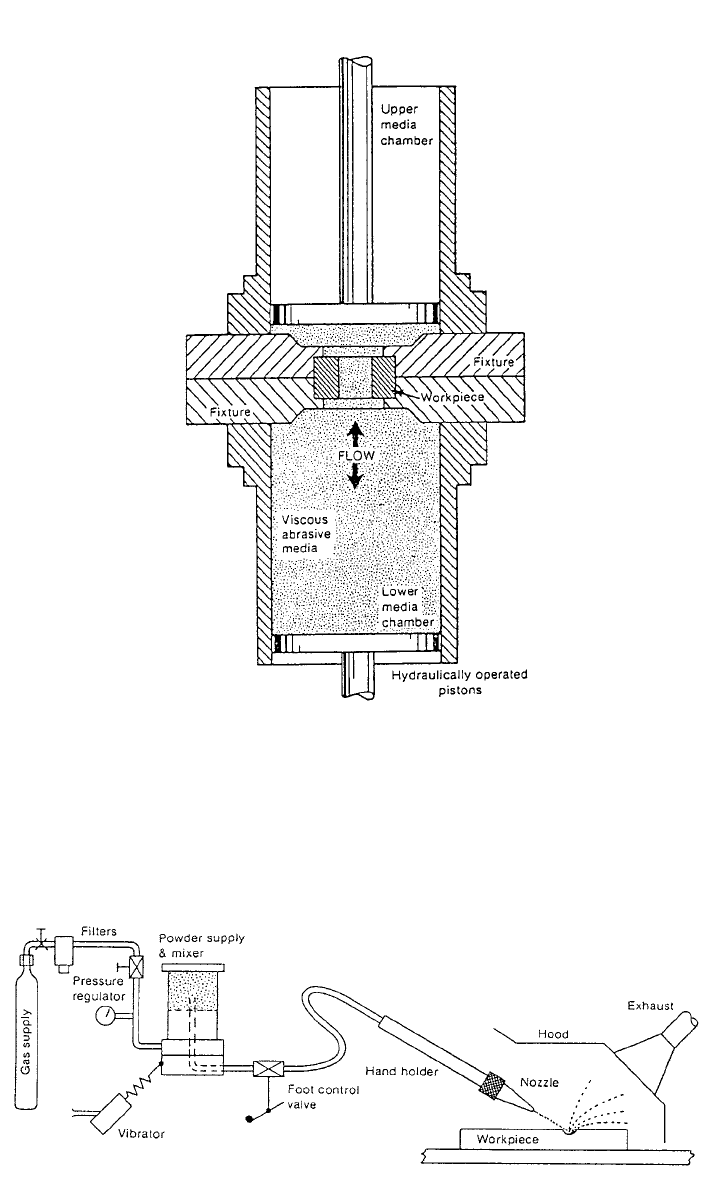
904 PRODUCTION PROCESSES AND EQUIPMENT FOR METALS
Fig. 31 Abrasive flow machining.
Fig. 32 Abrasive jet machining.
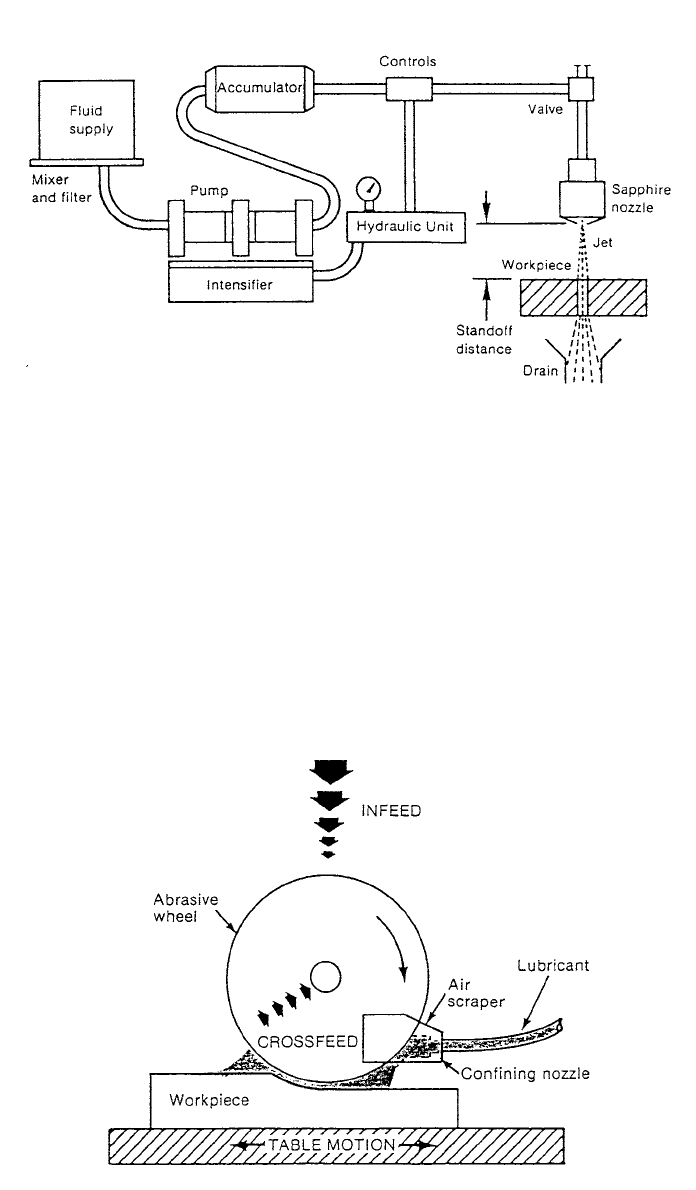
16 NONTRADITIONAL MACHINING 905
Fig. 33 Hydrodynamic machining.
Fig. 34 Low-stress grinding.
(3600⬚C). The torch can produce 2000⬚F (1100⬚C) in the workpiece in approx-
imately one-quarter revolution of the workpiece between the point of application
of the torch and the cutting tool.
16.6 Electromechanical Machining
Electromechanical machining (EMM) is a process in which the metal removal
is effected in a conventional manner except that the workpiece is electrochem-
ically polarized. When the applied voltage and the electrolytic solution are con-
trolled, the surface of the workpiece can be changed to achieve the characteristics
suitable for the machining operation.
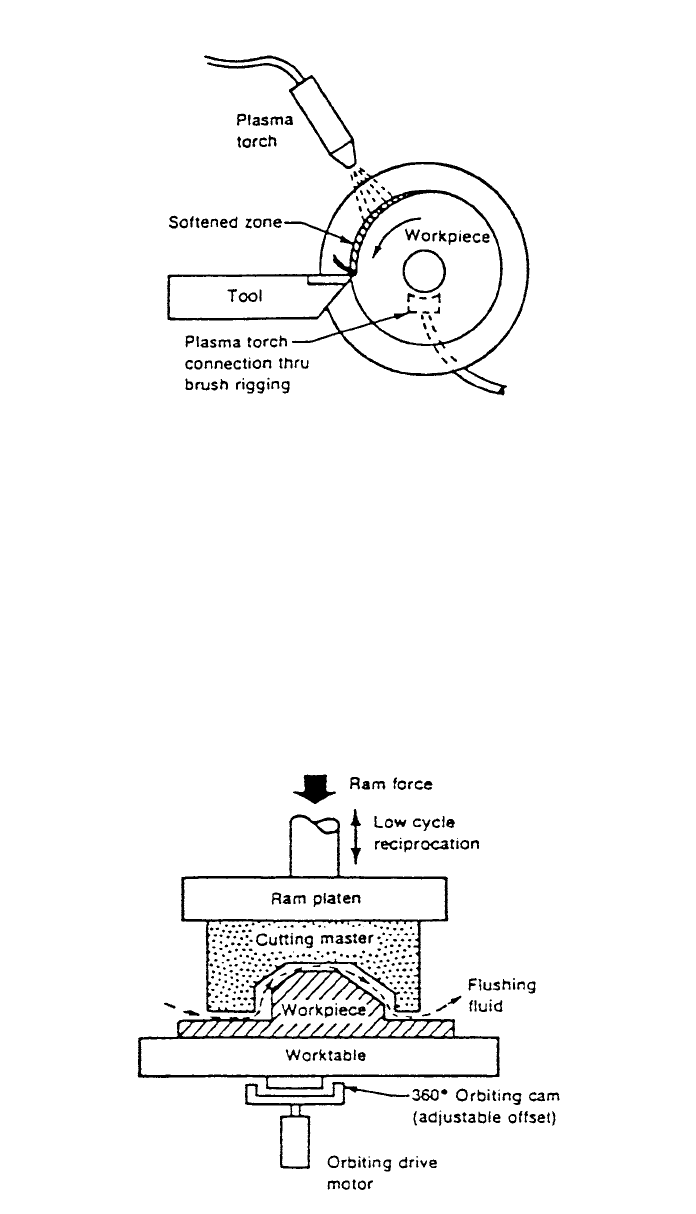
906 PRODUCTION PROCESSES AND EQUIPMENT FOR METALS
Fig. 35 Thermally assisted machining.
Fig. 36 Total form machining.
16.7 Total Form Machining
Total form machining (TFM) is a process in which an abrasive master abrades
its full three-dimensional shape into the workpiece by the application of force
while a full-circle, orbiting motion is applied to the workpiece via the worktable
(Fig. 36). The cutting master is advanced into the work until the desired depth
of cut is achieved. Uniformity of cutting is promoted by the fluid that continu-
ously transports the abraded particles out of the working gap. Adjustment of the
orbiting cam drive controls the precision of the overcut from the cutting master.
Cutting action takes place simultaneously over the full surface of abrasive con-
tact.
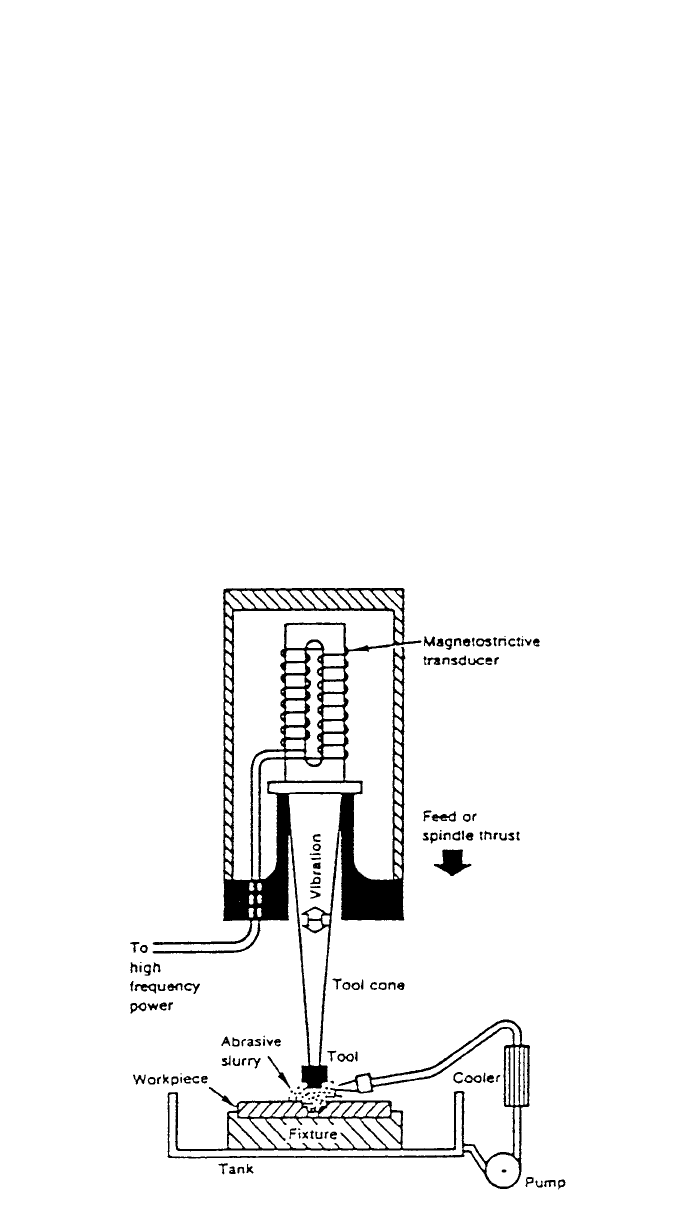
16 NONTRADITIONAL MACHINING 907
Fig. 37 Ultrasonic machining.
16.8 Ultrasonic Machining
Ultrasonic machining (USM) is the removal of material by the abrading action
of a grit-loaded liquid slurry circulating between the workpiece and a tool vi-
brating perpendicular to the workface at a frequency above the audible range
(Fig. 37). A high-frequency power source activates a stack of magnetostrictive
material, which produces a low-amplitude vibration of the toolholder. This mo-
tion is transmitted under light pressure to the slurry, which abrades the workpiece
into a conjugate image of the tool form. A constant flow of slurry (usually
cooled) is necessary to carry away the chips from the workface. The process is
sometimes called ultrasonic abrasive machining (UAM) or impact machining.
A prime variation of USM is the addition of ultrasonic vibration to a rotating
tool—usually a diamond-plated drill. Rotary ultrasonic machining (RUM) sub-
stantially increases the drilling efficiency. A piezoelectric device built into the
rotating head provides the needed vibration. Milling, drilling, turning, threading,
and grinding-type operations are performed with RUM.
16.9 Water-Jet Machining
Water-jet machining (WJM) is low-pressure hydrodynamic machining. The pres-
sure range for WJM is an order of magnitude below that used in HDM. There
are two versions of WJM: one for mining, tunneling, and large-pipe cleaning
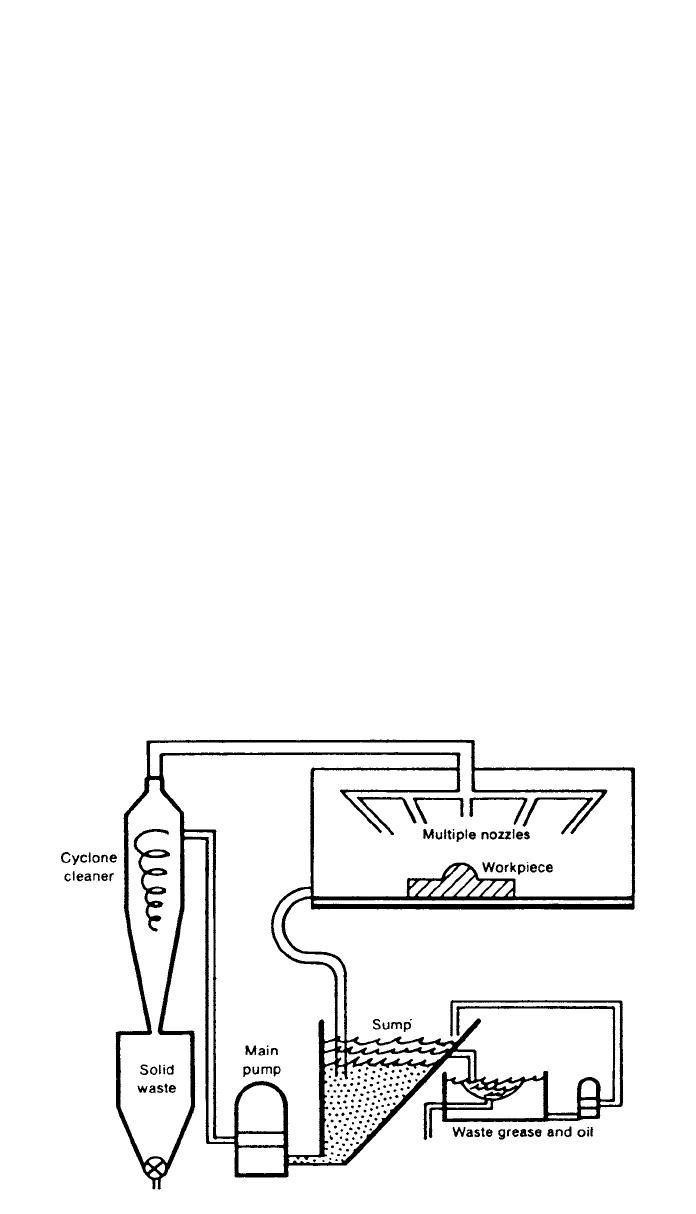
908 PRODUCTION PROCESSES AND EQUIPMENT FOR METALS
Fig. 38 Water-jet machining.
that operates in the region from 250–1000 psi (1.7–6.9 Mpa); and one for
smaller parts and production shop situations that uses pressures below 250 psi
(1.7 Mpa).
The first version, or high-pressure range, is characterized by use of a pumped
water supply with hoses and nozzles that generally are hand-directed. In the
second version, more production-oriented and controlled equipment, such as that
shown in Fig. 38, is involved. In some instances, abrasives are added to the fluid
flow to promote rapid cutting. Single or multiple-nozzle approaches to the work-
piece depend on the size and number of parts per load. The principle is that
WJM is high-volume, not high-pressure.
16.10 Electrochemical Deburring
Electrochemical deburring (ECD) is a special version of ECM (Fig. 39). ECD
was developed to remove burrs and fins or to round sharp corners. Anodic dis-
solution occurs on the workpiece burrs in the presence of a closely placed ca-
thodic tool whose configuration matches the burred edge. Normally, only a small
portion of the cathode is electrically exposed, so a maximum concentration of
the electrolytic action is attained. The electrolyte flow usually is arranged to
carry away any burrs that may break loose from the workpiece during the cycle.
Voltages are low, current densities are high, electrolyte flow rate is modest, and
electrolyte types are similar to those used for ECM. The electrode (tool) is
stationary, so equipment is simpler than that used for ECM. Cycle time is short
for deburring. Longer cycle time produces a natural radiusing action.
16.11 Electrochemical Discharge Grinding
Electrochemical discharge grinding (ECDG) combines the features of both elec-
trochemical and electrical discharge methods of material removal (Fig. 40).
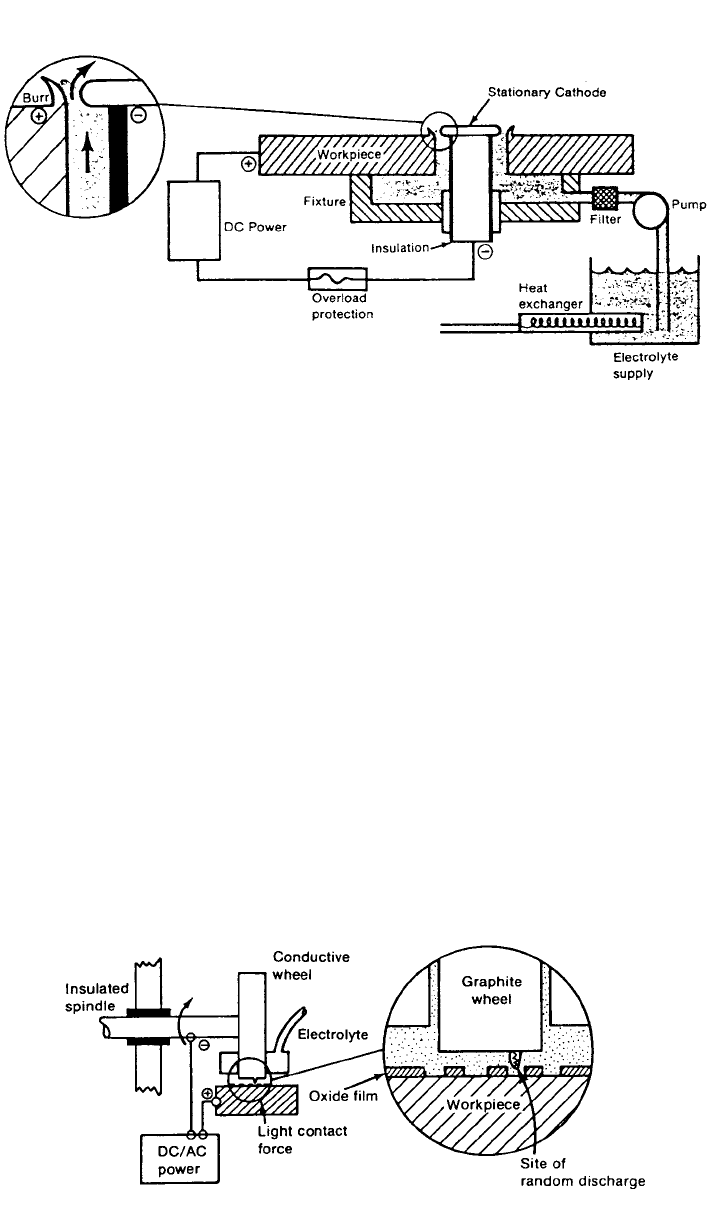
16 NONTRADITIONAL MACHINING 909
Fig. 39 Electrochemical deburring.
Fig. 40 Electrochemical discharge grinding.
ECDG has the arrangement and electrolytes of electrochemical grinding (ECG),
but uses a graphite wheel without abrasive grains. The random spark discharge
is generated through the insulating oxide film on the workpiece by the power
generated in an ac source or by a pulsating dc source. The principal material
removal comes from the electrolytic action of the low-level dc voltages. The
spark discharges erode the anodic films to allow the electrolytic action to con-
tinue.
16.12 Electrochemical Grinding
Electrochemical grinding (ECG) is a special form of electrochemical machining
in which the conductive workpiece material is dissolved by anodic action, and
any resulting films are removed by a rotating, conductive, abrasive wheel (Fig.
41). The abrasive grains protruding from the wheel form the insulating electrical
gap between the wheel and the workpiece. This gap must be filled with electro-
lyte at all times. The conductive wheel uses conventional abrasives—aluminum
oxide (because it is nonconductive) or diamond (for intricate shapes)—but lasts
substantially longer than wheels used in conventional grinding. The reason for
this is that the bulk of material removal (95–98%) occurs by deplating, while
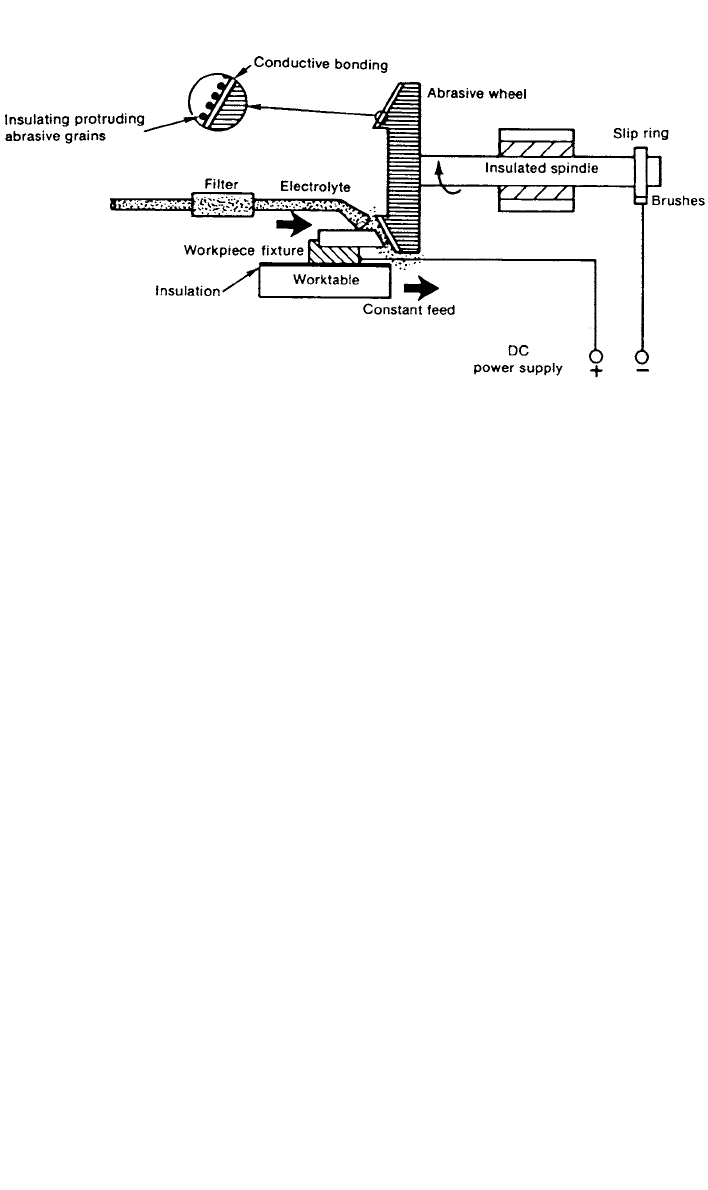
910 PRODUCTION PROCESSES AND EQUIPMENT FOR METALS
Fig. 41 Electrochemical grinding.
only a small amount (2–5%) occurs by abrasive mechanical action. Maximum
wheel contact arc lengths are about –1 in. (19–25 mm) to prevent overheating
3
–
4
the electrolyte. The fastest material removal is obtained by using the highest
attainable current densities without boiling the electrolyte. The corrosive salts
used as electrolytes should be filtered and flow rate should be controlled for the
best process control.
16.13 Electrochemical Honing
Electrochemical honing (ECH) is the removal of material by anodic dissolution
combined with mechanical abrasion from a rotating and reciprocating abrasive
stone (carried on a spindle, which is the cathode) separated from the workpiece
by a rapidly flowing electrolyte (Fig. 42). The principal material removal action
comes from electrolytic dissolution. The abrasive stones are used to maintain
size and to clean the surfaces to expose fresh metal to the electrolyte action.
The small electrical gap is maintained by the nonconducting stones that are
bonded to the expandable arbor with cement. The cement must be compatible
with the electrolyte and the low dc voltage. The mechanical honing action uses
materials, speeds, and pressures typical of conventional honing.
16.14 Electrochemical Machining
Electrochemical machining (ECM) is the removal of electrically conductive ma-
terial by anodic dissolution in a rapidly flowing electrolyte, which separates the
workpiece from a shaped electrode (Fig. 43). The filtered electrolyte is pumped
under pressure and at controlled temperature to bring a controlled-conductivity
fluid into the narrow gap of the cutting area. The shape imposed on the work-
piece is nearly a mirror or conjugate image of the shape of the cathodic elec-
trode. The electrode is advanced into the workpiece at a constant feed rate that
exactly matches the rate of dissolution of the work material. Electrochemical
machining is basically the reverse of electroplating.
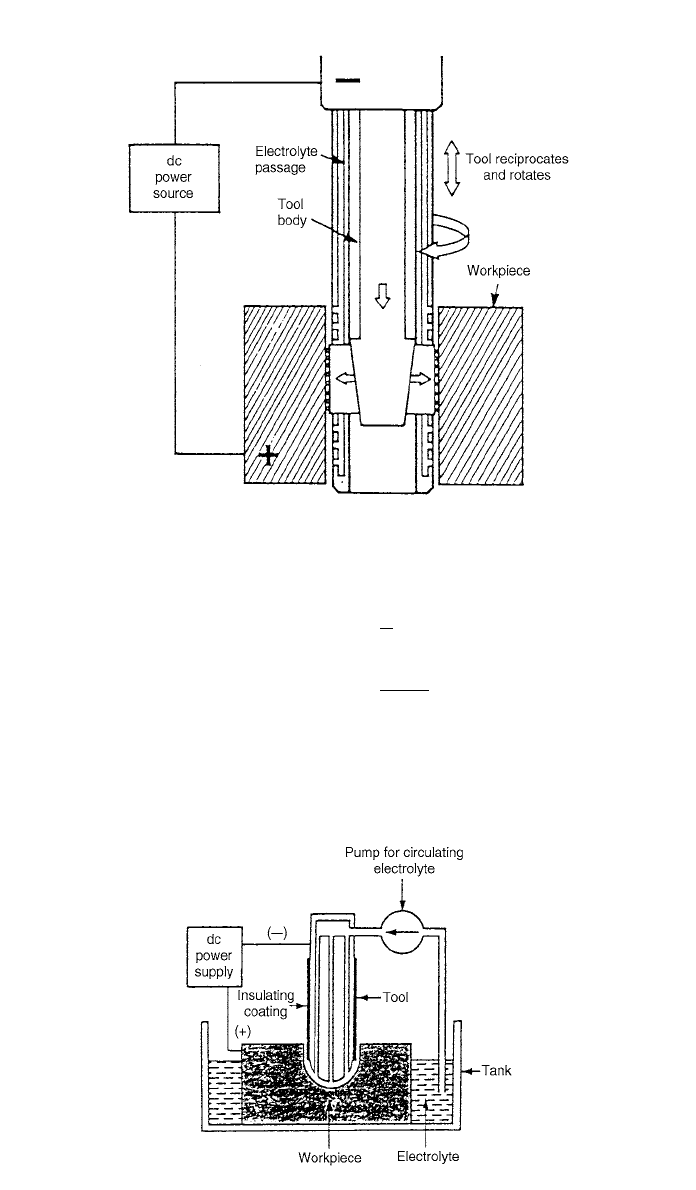
16 NONTRADITIONAL MACHINING 911
Fig. 42 Electrochemical honing.
Fig. 43 Electrochemical machining.
Calculation of Metal Removal and Feed Rates in ECM
V
current I ⫽ amp
R
g
⫻ r
resistance R ⫽
A
where g
⫽ length of gap (cm)
r
⫽ electrolyte resistivity

912 PRODUCTION PROCESSES AND EQUIPMENT FOR METALS
A ⫽ area of current path (cm
2
)
V
⫽ voltage
R
⫽ resistance
IV
2
current density S ⫽⫽ amp/cm
Ar
⫻ g
The amount of material deposited or dissolved is proportional to the quantity of
electricity passed (current
⫻ time).
amount of material
⫽ C ⫻ I ⫻ t
where C
⫽ constant
t
⫽ time, sec
The amount removed or deposited by one faraday (96,500 coulombs
⫽ 96,500
amp–sec) is 1 gram-equivalent weight (G)
N
G ⫽ (for 1 faraday)
n
where N
⫽ atomic weight
n
⫽ valence
I
⫻ tN1
volume of metal removed ⫽⫻⫻⫻h
96,500 nd
where d
⫽ density, g/cm
3
h ⫽ current efficiency
N 1
3
specific removal rate s ⫽⫻ ⫻h cm /amp–sec
n 96,500
cathode feed rate F
⫽ S ⫻ s cm/sec.
16.15 Electrochemical Polishing
Electrochemical polishing (ECP) is a special form of electrochemical machining
arranged for cutting or polishing a workpiece (Fig. 44). Polishing parameters
are similar in range to those for cutting, but without the feed motion. ECP
generally uses a larger gap and a lower current density than does ECM. This
requires modestly higher voltages. (In contrast, electropolishing (ELP) uses still
lower current densities, lower electrolyte flow, and more remote electrodes.)
16.16 Electrochemical Sharpening
Electrochemical sharpening (ECS) is a special form of electrochemical machin-
ing arranged to accomplish sharpening or polishing by hand (Fig. 45). A portable
power pack and electrolyte reservoir supply a finger-held electrode with a small
current and flow. The fixed gap incorporated on the several styles of shaped
